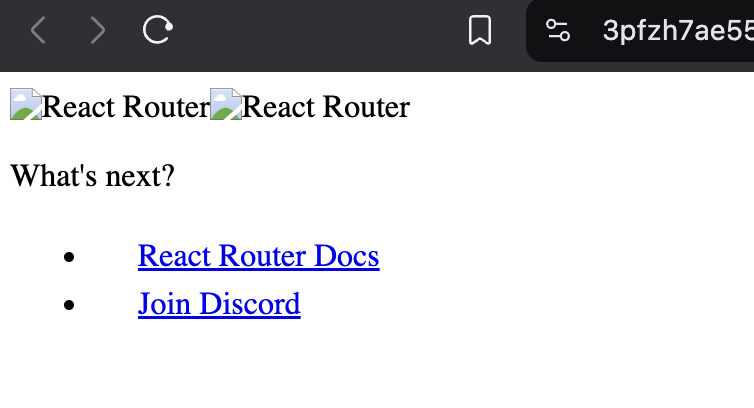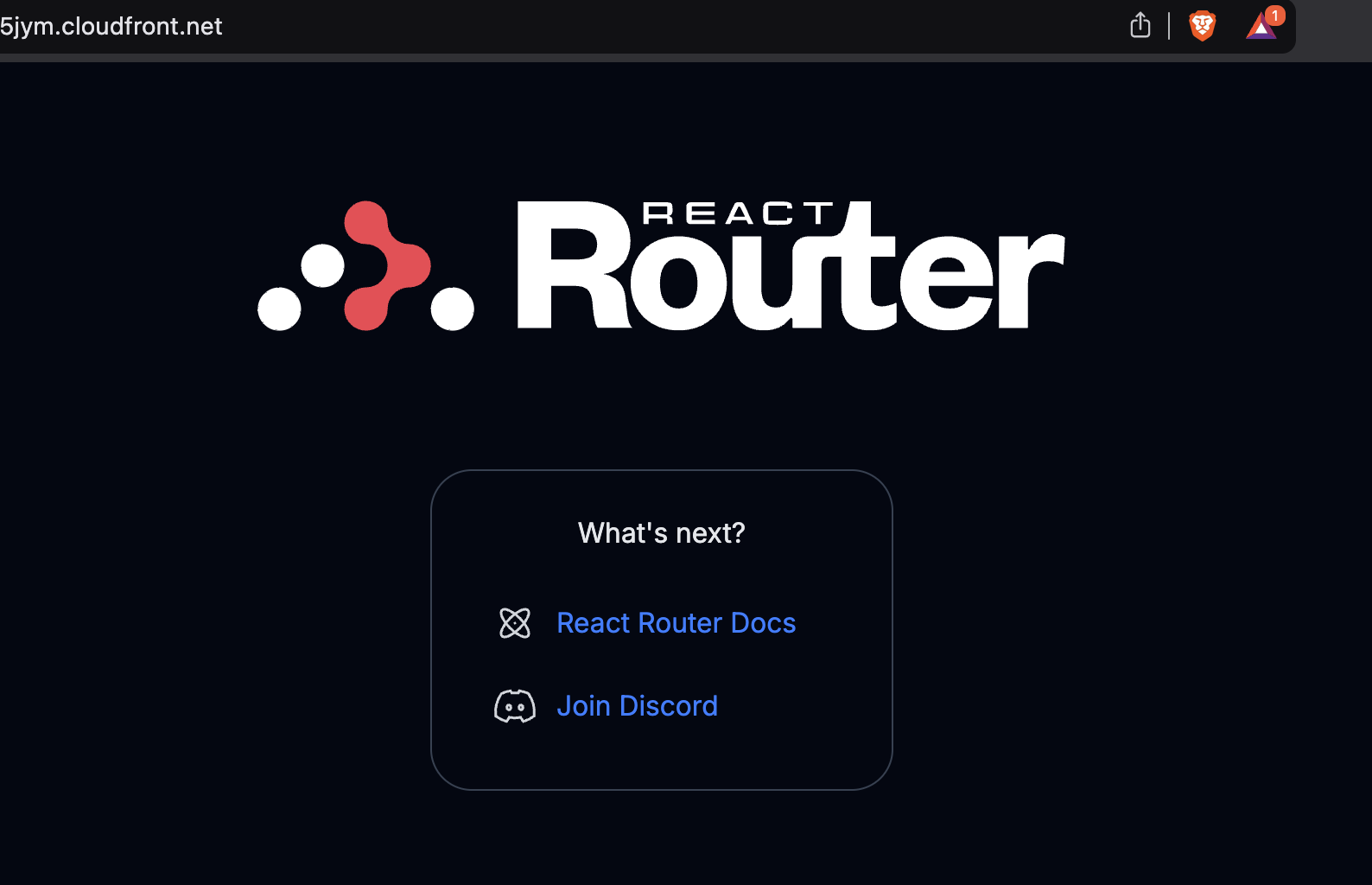Spinning up a React Router app on AWS Lambda - with server side rendering and everything - is pretty easy. Here, we'll be using the AWS CDK to define and create the resources in AWS.
Here's the working repo.
Set up React Router
For this demo, I'm just using create-react-router@latest to set up a new project:
npx create-react-router@latest ./react-router-lambda
For more complex projects, the Epic Stack is a great template to start from.
You can follow this article through the commit history in the react-router-lambda template repository. Here's the first commit.
Add Lambda Handler
React Router itself isn't a server, but provides adapters for different servers. Install the @react-router/architect package:
npm install @react-router/architect
Then, the handler itself is a simple wrapper of the build:
// server/lambda.ts
import { createRequestHandler } from '@react-router/architect'
// @ts-ignore (no types declared for build)
import * as build from '../build/server'
export const handler = createRequestHandler({
build,
mode: process.env.NODE_ENV,
})
This is all the code we're going to set up; check out the commit here.
Now, let's dig into the CDK to make this run in AWS.
Set up CDK
AWS CDK is a toolkit for defining infrastructure as code, which is great for consistent and reproducible deployments. We'll set up a few pieces: the server handler will run on Lambda; static client-side files (including CSS and Javascript) will be served from an S3 bucket; and a CloudFront distribution will split traffic between the two.
For the purposes of this demo, I'm going to get the initial files from cdk init in an empty directory and then integrate the generated files into the React Router app. In a production app with multiple services, you might want to maintain the infrastructure separately from the app.
I'm going to simplify things a bit and put the bin/cdk.ts and lib/cdk-stack.ts in ./cdk/. I'm keeping the cdk.json file and adding the few necessary dependencies to package.json.
I did make one change in the cdk.json file, switching from ts-node to tsx for compatibility with the React Router Typescript setup:
{
"app": "npx tsx cdk/cdk.ts",
// ...
Check out the commit here with the initial CDK setup.
Lambda with Function URL
Time to set up the cdk-stack!
AWS provides a NodejsFunction construct that handles some of the packaging for us to build and deploy the server handler to Lambda. We'll use a function URL to invoke the Lambda rather than something like API Gateway.
// Set absolute path to the lambda.ts handler
// __dirname is not available in ESM, but we can set it ourselves
const __dirname = path.dirname(fileURLToPath(import.meta.url))
const entry = path.join(__dirname, '../server/lambda.ts')
// Create Lambda function for React Router
const lambdaFunction = new nodejs.NodejsFunction(this, 'ReactRouterHandler', {
runtime: lambda.Runtime.NODEJS_22_X,
handler: 'handler',
entry,
bundling: {
externalModules: [
'@aws-sdk/*',
'aws-sdk', // Not actually needed (or provided) - see below
],
minify: true,
sourceMap: true,
target: 'es2022',
},
environment: {
NODE_ENV: 'production',
},
})
// Create Function URL for the Lambda
const functionUrl = lambdaFunction.addFunctionUrl({
authType: lambda.FunctionUrlAuthType.NONE,
})
The old aws-sdk v2 dependency is included in the externalModules as a workaround - the @react-router/architect package has some out-of-date dependencies, but we don't actually need them for this.
If you deploy at this point, you can invoke the Lambda via its function URL! However, we're still missing the static resources. Let's publish those to an s3 bucket.

Static Bucket
Because the resources in the bucket will be served via CloudFront, the bucket itself does not need to be publicly accessible:
// Create S3 bucket for static assets
const staticBucket = new s3.Bucket(this, 'StaticBucket', {
enforceSSL: true,
publicReadAccess: false,
blockPublicAccess: s3.BlockPublicAccess.BLOCK_ALL,
removalPolicy: cdk.RemovalPolicy.DESTROY,
autoDeleteObjects: true,
})
CloudFront Distribution
Then we'll set up the CloudFront distribution. Note that we are disabling caching on the default behavior (the lambda) and using optimized caching on the static bucket. We're also using a BucketDeployment to publish the static assets to the bucket: this will automatically reset the CloudFront distribution's cache when resources are published.
// Create CloudFront distribution
const distribution = new cloudfront.Distribution(this, 'Distribution', {
defaultBehavior: {
origin: new origins.FunctionUrlOrigin(functionUrl),
viewerProtocolPolicy: cloudfront.ViewerProtocolPolicy.REDIRECT_TO_HTTPS,
allowedMethods: cloudfront.AllowedMethods.ALLOW_ALL,
cachedMethods: cloudfront.CachedMethods.CACHE_GET_HEAD_OPTIONS,
originRequestPolicy:
cloudfront.OriginRequestPolicy.ALL_VIEWER_EXCEPT_HOST_HEADER,
cachePolicy: cloudfront.CachePolicy.CACHING_DISABLED,
},
additionalBehaviors: {
'/assets/images/*': {
origin: origins.S3BucketOrigin.withOriginAccessControl(staticBucket, {
originAccessLevels: [
cloudfront.AccessLevel.READ,
cloudfront.AccessLevel.LIST,
],
}),
viewerProtocolPolicy: cloudfront.ViewerProtocolPolicy.REDIRECT_TO_HTTPS,
allowedMethods: cloudfront.AllowedMethods.ALLOW_GET_HEAD_OPTIONS,
cachedMethods: cloudfront.CachedMethods.CACHE_GET_HEAD_OPTIONS,
cachePolicy: cloudfront.CachePolicy.CACHING_OPTIMIZED,
},
},
})
// Deploy static assets to S3
new s3deploy.BucketDeployment(this, 'DeployStaticAssets', {
sources: [
s3deploy.Source.asset(path.join(__dirname, '../build/client/assets')),
],
destinationBucket: staticBucket,
destinationKeyPrefix: 'assets',
distribution,
distributionPaths: ['/assets/images/*'],
})
Here's the final commit with the CDK setup.
Wrap up
And that's it! If you deploy these changes and visit the Cloudfront domain, you'll see the React Router splash page:

Obviously, there are more things you'd want to set up in a production stack - a custom domain, a WAF, perhaps a database, etc. But this minimal stack shows how easy it can be to deploy React Router to Lambda.